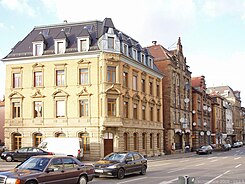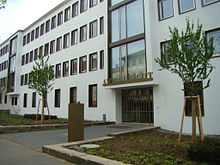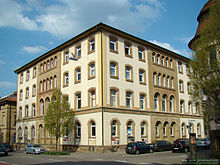Wilhelmstrasse (Heilbronn)
| Wilhelmstrasse | |
|---|---|
| Street in Heilbronn | |
| South end of Wilhelmstrasse, house number 68 in the foreground | |
| Basic data | |
| place | Heilbronn |
| District | Heilbronn |
| Cross streets | u. a. Cäcilienstraße, Innsbrucker Straße, Luisenstraße, Südstraße, Werderstraße |
| Numbering system | Orientation numbering |
| Buildings | see section Buildings and Companies |
| use | |
| User groups | Car traffic , pedestrian traffic , bicycle traffic , public transport |
The Wilhelmstrasse is a street in Heilbronn. It forms a traffic artery in a north-south direction. Numerous historical buildings have been preserved on Wilhelmstrasse, most of which are now under monument protection .
Location and traffic
Wilhelmstrasse runs as a one-way street from the former Fleinertor southwards to Rathenauplatz . Among other things, it crosses Südstraße . From this intersection to its end at Rathenauplatz, it forms part of the B 27 , but only in a southerly direction due to the one-way traffic regulations. The B 27 in a northerly direction is formed by Urbanstrasse.
The traffic flows divide at Rathenauplatz. In the direction of Flein , the Charlottenstraße leads as an extension of Wilhelmstraße , in the direction of Sontheim the Sontheimer Straße, which is the continuation of the B 27. Wilhelmstrasse is used by both private and public transport.
history
Wilhelmstrasse is a historic traffic axis in Heilbronn. From the Fleinertor, the former city limits, it started traffic in the direction of Flein, Lauffen and Stuttgart . At the beginning of the 19th century the old city fortifications were removed. Louis de Millas planned the "leveling of the state road from Fleinerthor to the so-called Steinweg". From the demolition of the fortifications and especially around the middle of the 19th century, the garden area on Wilhelmstrasse up to around Südstrasse was built on with villas, many of which have been preserved between Wollhausplatz and Südstrasse. The development was funded in anticipation of the planned train station, which was originally intended to be located south of Heilbronn's old town, but was never built there. Among other things, the Wilhelmsbau on the corner of Cäcilienstraße , which is now used as the technical town hall, dates back to that time. The southern half between Südstrasse and Rathenauplatz was built with residential and commercial buildings in the second half of the 19th century. Since this part of Heilbronn was less affected by the air raids during the Second World War than the old town to the north, many buildings from the 19th century have been preserved in Wilhelmstrasse. According to the monument topography, “the function of the once noble street has changed radically due to the increasing traffic load and the construction of shopping centers.” The northern end of Wilhelmstrasse with Fleiner Platz was completely redesigned when the Wollhauszentrum was built in the early 1970s. The eastern development of the southern half of Wilhelmstraße mainly consists of modern commercial buildings.
Surname
Wilhelmstrasse has had her name with interruptions since 1840/41; it is for the King of Württemberg I. Wilhelm named. In 1938 it was renamed Wiener Straße, after the Second World War it was given its old name back in 1945, but was given the name Tübinger Straße for a short time in 1947/48 before it was called Wilhelmstraße again.
Buildings and companies
- Wilhelmstrasse 1 was once located on Fleiner Platz , which was abandoned when the Wollhauszentrum was built and the street layout was changed in this area. Wilhelmstrasse 1/1 was a riding house that could also be used as a circus hall. It was from Louis de Millas. In the period after the Second World War, there was a large Esso filling station at Wilhelmstrasse 1.
- Wilhelmstrasse 2-6 is Amtsgericht Heilbronn resident who Nos. 8-12 demonstrates the Heilbronn District Court . Wilhelmstrasse 4 was once the seat of the cardboard tube and paper goods factory Dr. Steinau & Brandt. The house Wilhelmstrasse 8 could be the banker Hugo von Rümelin of Ernst Walter and Karl Luckscheiter build. From 1876 to 1891 the Heilbronn branch of the Reichsbank was located in No. 10. The buildings were destroyed in World War II, and the current courthouse was built.
- After the Second World War, the Egerter bottle mill was located in Wilhelmstrasse 3, before the Fromm furniture store was built there until the 1960s.
- Since the time after the Second World War, the Schneider paper and office supplies store has been located in Wilhelmstrasse 5, with an associated printing and bookbinding shop in the rear building. Today there is a hairdresser in number 5.
- The Villa Goppel at Wilhelmstrasse 7 is a classicist building by Louis de Millas. No. 7 and 7a once belonged to the Jewish honorary citizen Max Rosengart . The building came into the possession of the city of Heilbronn in 1937 and is now part of the technical town hall in the neighboring Wilhelmsbau .
- Heinrich Cluss built the house at Wilhelmstrasse 9 . The building, named after the builder Clussbau and Wilhelmsbau after the street , was acquired by the city of Heilbronn in 1901, added to and used as an administration building ever since.
- The Villa bucket , Wilhelmstrasse 11, also from Louis de Millas and has subsequently grown garden porch, which was designed by Walter and Luckscheiter.
- The classicist Villa Zapf at Wilhelmstrasse 13 was built according to plans by the Heilbronn architect Franz Weisert . After the Second World War, the building was the seat of the police headquarters; today it is used for catering purposes.
- In 1950, Carl Haering's paint wholesaler was located in No. 14/1, and later the Jurkowski toy shop.
- Gustav Fuchß's bakery was in No. 15 after the Second World War.
- Foreman Gieß planned the house at Wilhelmstrasse 16 himself. It shows late classicist and neo-renaissance forms .
- The residential and commercial building at Wilhelmstrasse 17 was designed by the architects Beutinger & Steiner and has a richly decorated sandstone facade .
- The official building of the Protestant deanery at Wilhelmstraße 18 was built according to plans by the city architect Gustav Wenzel and rebuilt in its old form after the war.
- No. 19 was a purely commercial building in 1950. This included the Staufenberg inn owned by the house owner Julie Hoch, Georg Röhrig's leather goods shop, a women's cosmetics study by Elsbeth Düllmann, and Fritz Langenfelder's sewing machine and bicycle shop. Apartments and offices were later rented. The graphic artists Bruno Velten and Gerhard Binder lived in the building and ran their office community Velten-Binder there.
- From 1904 there was a specialist electronics store at Wilhelmstrasse 21. In 1950 the city councilor Otto Läpple lived on the upper floor. The building was later used by the old-age insurance, the drug wholesaler Andreae-Noris Zahn and doctors, and the Stern pharmacy was also located in it.
- No. 22 was Eugen Faßbender's gold and silversmiths in 1950, two leather and textile dealers were also rented, and later Josef Jeser's express cleaning.
- No. 23 with 23/1 and 23/2 was in 1950 the Heermann car dealership. Several apartments were rented in No. 23/2.
- From 1920 to 1944, the Billing hairdressing salon was located in No. 24. Ewald Billing had previously been a theater hairdresser in Hanover. In the post-war period the building belonged to the carpenter Karl Fromm. The business premises of Unterländer Raumkunst oHG Gebrüder Fromm were on the ground floor, while the Parapack Institute of the Weber brothers was on the first floor . In 1961, S. Latasch ran the palette dance café there , and the German Book Association had its bookroom on the first floor. Latasch later moved to the extension of the nearby building at Sontheimer Str. 9 and ran the snack bar in Heilbronn's red light district. In Wilhelmstrasse 24/1 there was a branch of the book wholesaler Umbreit , on the second floor there was a branch of the Berlitz language schools .
- The Villa Seelig at Wilhelmstrasse 25 is based on a design by Robert von Reinhardt . The building was the director's villa for the neighboring Seelig coffee agent factory and later served various residential and commercial purposes, and city offices also used rooms in the building at times.
- No. 26 once belonged to Richard and Gertrud Oppenheimer. Gustav Neutz's meat and sausage company was in the annex in 1950. In 1961, the Heermann car dealership bought the property and moved the administration there.
- Emil Seelig had his chicory coffee factory at Wilhelmstrasse 27, later the Seelig & Diller coffee product factory. After the end of the company, the Heermann car dealership also acquired this property and rented it out. Among other things, the police patrol service, the municipal compensation office and a fire department store were there. In the outbuildings there was a doctor's practice, an office of the Red Cross and apartments.
- In 1950, no. 28 housed Karl Heinrich's yeast, fruit and vegetable store, Emil Hagenmeyer's grocery store and Eugen Dierolf's paper wholesaler.
- No. 30 with outbuildings was owned by Emil Hagenmeyer's heirs in 1950. No. 30 was first Josefine Hoppe's brush shop and then Anton Essig's textile shop, as well as Paul Romahn's dye works shop, and in 30/1 Erich Beitler had a tailor's workshop for a long time. In addition, numerous apartments were rented.
- No. 32 was the building of the Schlipf bakery in 1950, and Helene Sailer also ran a flower shop in it, which was later continued by Hellmut Schneider.
- The company Krämer & Flammer had offices in No. 33 and their soap factory in No. 35. The Flammer site was later built over with the City-Süd-Center.
- Karl Opper ran the showcase in No. 34, and the Hildmann fruit and vegetable shop was also there.
- The house Wilhelmstrasse 36a was later given the address Südstrasse 49. Professor Hermann Stockmayer from Stuttgart had the house built in 1869, which later housed the boarding school of the widow Kozel. A so-called Werkbundhaus, which was supposed to be built on the narrow side plot in 1931, was never implemented. The Kozel boarding house has not survived; The Arbeiter-Samariter-Bund is now located on the corner of Wilhelmstrasse and Südstrasse .
- After the Second World War, the butcher's Fröschle was located at Wilhelmstraße 40, before the butcher's shop Klumpp, which was previously located at Südstraße 43, took over the business in 1969. Gustav Uhland's veterinary practice was also located there and numerous apartments were rented in No. 40 and 40/1.
- Villa Eckert at Wilhelmstrasse 42 has a romantic design. The house is in the second row from the street and has a turret. In addition to apartments, the building also contained the Düringer medical supply store.
- After the Second World War, No. 43 was the building of the Stirn bakery, which was continued by Franz Jilek.
- After the Second World War, No. 45 was purely a commercial building, in which in 1950 Paula Gerstlauer owned a hat shop, Deutsche Hochsee-Fischerei AG owned a fish sales point and Robert Model owned a textile shop. In 1961, in addition to the Model textile shop, there was a curtain tensioner and a laundry acceptance point.
- The house at Wilhelmstrasse 47 was built for the piano factory CF Glass & Co. , which had previously been housed in the Wilhelmsbau. In 1930 it was bought by the Edeka Group, which continued to use it after the Second World War. In 1950, it also housed Franz Bedenk's orthopedic mechanic workshop, the Hippel clothing store, Eugen Horch's health food store and several apartments. In 1961, apart from Edeka and a sales representative, the house was only used for residential purposes.
- In 1950, Raffaele Navazcio's Capri drugstore was located in Wilhelmstrasse 50, later Carlo Lotito's Café Milano was added and used the income tax office of the tax office on several upper floors.
- Wilhelmstrasse 51 was rebuilt in a modified form after the war as the seat of the Wilhelm Pfau envelope factory.
- August Dederer designed the residential and commercial buildings at Wilhelmstrasse 52 , 54 and 56 . The late historical facades are elaborately designed. In the post-war period, No. 52 belonged to a locksmith who had his workshop in the rear building. No. 54 once belonged to the Jewish paper wholesalers Berthold and Ludwig Marx, who were expropriated in the Third Reich. Pharmacists Koch bought the house from the heirs and taught in the Rose Pharmacy one. No. 56 was the general store Model, as well as a locksmith, construction company, and office supply retailer. Today the building is the editorial office of the HANIX company magazine .
- Albert Zern's photo studio was in Wilhelmstrasse 53.
- The Hotel Hubmann at Wilhelmstrasse 58 was also designed by August Dederer. In the early 1930s, Heinrich and Emilie Hiller's Viktoria coffee restaurant was there . The building was expropriated from the property of the SPD-related club printing house by the National Socialists and later restituted. The ground floor is still used for gastronomy today.
- In the post-war period, Emma and Max Riedt ran a grocery store and a yarn wholesaler in house no. 60, and later the Nikolai drug store was in the building.
- In 1950, house number 62 was the jewelry store of Robert Luithle, and later a dry cleaner.
- The house at Wilhelmstrasse 64 was planned by the architect Schulz for the stove manufacturer Franz Schafferdt. After the Second World War it was a butcher's shop. When the Heilbronn red light district established itself on Rathenauplatz in the 1970s, the shop on the ground floor was converted into a pub.
- The house at Wilhelmstrasse 66 , designed by the architect Friedrich Schneider , is adorned with neo-Gothic architectural sculpture . In the post-war period there was a fruit and vegetable shop as well as a grocery store; later, the ground floor and that of the neighboring house were converted into a pub.
- Heinrich Stroh designed the Hotel Europäische Hof at Wilhelmstrasse 68 on the corner of Rathenauplatz for Heinrich Schlette. At the time of the red light district on Rathenauplatz, it was a breakfast and night bar.
- Some buildings on the other side of Rathenauplatz originally belonged to Wilhelmstraße, but were then added to Charlottenstraße. Wilhelmstraße 76 became Charlottenstraße 12, Wilhelmstraße 78 became Charlottenstraße 14.
literature
- Julius Fekete et al., Monument Topography Baden-Württemberg. Volume I.5 Heilbronn district , Konrad Theiss Verlag, Stuttgart 2007, ISBN 978-3-8062-1988-3 , pp. 137-140.
- City of Heilbronn (ed.): Address book of the city of Heilbronn 1950 , Heilbronn 1950.
- City of Heilbronn (ed.): Address book of the city of Heilbronn 1961 , Heilbronn 1961.
Web links
Individual evidence
- ^ Plan by Louis de Millas in the Heilbronn City Archives
- ^ Julius Fekete et al., Monument topography Baden-Württemberg. Volume I.5 Heilbronn district , Konrad Theiss Verlag, Stuttgart 2007, ISBN 978-3-8062-1988-3 , p. 137
- ^ Gerhard Schwinghammer, Reiner Makowski: The Heilbronner street names , Silberburg-Verlag Tübingen 2005, ISBN 978-3-87407-677-7 , p. 217 f.
- ↑ Chronicle of the City of Heilbronn 1922–1933, p. 85.
Coordinates: 49 ° 8 ′ 4 ″ N , 9 ° 13 ′ 7.5 ″ E






